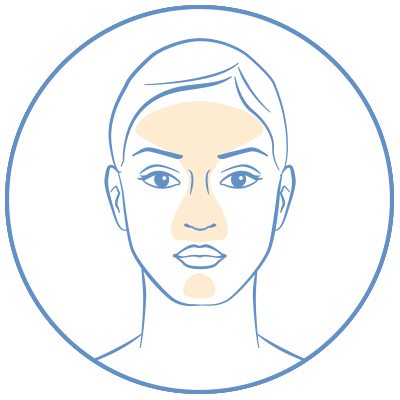Oily skin
Oily skin has no dry area on the skin and is oily overall skin and happens when the sebaceous glands in the skin make too much sebum. Sebum is a waxy, oily substance that protects and hydrates the skin. People with oily skin have excessive sebum secretion, their faces look oily, skin troubles often occur, and they worry with wide pores.
The main characteristics of oily skin include:
- Because of the significant amount of sebum secretion, skin troubles often happen.
- Not long after washing your face, your face gets oily.
- Your skin gets pimples often and is rough and get large facial pores.
- You have had bad makeup these days and it erases easily. Especially, your makeup gets ruined and erased in the afternoon, the makeup on the T-zone is easily erased.
- Your skin is oily and your face is sticky and gets a foreign substance easily stained on your face.
- Your skin color is dull overall or your capillaries are dilated, making your skin look red.
- You have easily dandruff on your scalp.
There are many blackheads on your nose.
Oily skin can be subdivided as follows:
- Oily skin with too much oil
When you put on makeup, the area you’ve already done makeup moves a little or it gets cakey easily.
- Your overall skin looks oily from excessive oil.
- You don’t feel tightened or dry on your skin, but you often get skin trouble.
Oily skin with insufficient moisture
- You don’t apply moisturizing one in 15 minutes and you will feel your skin dry and tight.
- You have had often bad makeup when you have put on makeup.
- You are mainly oily in the T zone and the U zone is dry.
- You often get a very small pimple and skin trouble on your face.
Methods for managing oily skin are as follows.
- When washing your face, do not use alkaline soap or cleanser as much as possible and do deep cleansing.
- Do not use oil-based products to remove oil on your face.
- Wash your face twice or three times a day using soap or cleanser for oily skin.
- Use astringent after you wash your face.
- Use gel or lotion-type cream rather than the cream type that can block pores.
- Pimple is caused by wastes or dead skin cells on the surface of the skin, so you have to pay a lot of attention to getting rid of the dead skin cells.
→ Remove dead skin cells and sebum using scrub or peeling gel.
- Eat a lot of mushrooms, seaweed, and green and yellow vegetables that contain large amounts of vitamins B2 and B6 that help control sebum.
- Remove sebum and waste from pores using a toner dedicated to acne and use a sebum removal pack twice to three times a week, which is attached to your face and then taken off.
- When you wash your face, use warm water to rinse your face cleanly, and at the end, you should shrink your pores while rinsing your skin with cold water.
Dry skin
Dry skin is skin that doesn’t have enough moisture in it to keep it feeling soft and supple.
This type of skin has a low level of sebum and does not maintain oil easily.
No matter what you apply, dry skin that has severe dead skin cells and is rough like the bark of a tree.
The main characteristics of dry skin include:
-
Dry skin has severe tightness from inside skin, and the skin surface is dry and rough.
-
Especially, you can feel your skin tight severely, after washing your face.
-
You get skin aging phenomenon comes quickly because you getting wrinkles easily.
-
Sometimes your skin is itchy and your face is prone to itching.
-
You have fine wrinkles easily and have bad makeup because pores are small and delicate.
-
The small vein is often visible due to your thin skin.
-
Your skin is dry severely and flaky according to seasonal changes.
In severe cases, the dead skin cells are flaky just by rubbing your skin.
Especially, you have many fine wrinkles around your mouth and eyes.
-
If you have severely dry skin, it may be accompanied by other symptoms, such as itching and inflammation.
-
Because your pores are small, your skin seems to have a good skin texture, but your skin is not glossy.
-
Because of its weak skin resistance, allergic reactions or sensitive reactions are likely to appear.
-
You have a thin barrier, so if your skin is damaged, freckles and spots appear due to pigmentation.
-
Compared to other skin types, dry skin tends to get scars easily.
Dry skin can be subdivided as follows:
-
Age-related dry skin
It is also called ‘Dry skin due to aging of the skin’. Due to skin aging, the function of sweat glands and sebaceous glands is decreased, resulting in dry skin due to a lack of sebaceous membrane formation.
Methods for managing dry skin are as follows.
-
Drink plenty of water to prevent a lack of hydration.
-
Take vegetables or fruits that are high in vitamin C because they can cause stains and freckles.
-
Make sure to wash your face with lukewarm water, as washing your face with hot water can make your skin drier.
-
Use cleansing water with less alcohol content.
-
Use a slightly acidic cleansing foam.
-
If you exfoliate too much or do deep cleansing, the moisture layer of your skin will be damaged, so wash your face lightly using only water in the morning.
-
Recommend you to apply eye cream in the morning and at night to prevent wrinkles caused by dry skin.
-
Apply an oil and moisturizing pack to your face 2 to 3 times a week.
Normal skin
Normal skin is skin without oily or dry areas because the oil balance is well adjusted.
The main characteristics of normal skin include:
- Normal skin is the most ideal skin because it has good oil and moisture balance.
- This type of skin has a moist and smooth skin texture, makeup looks good, and makeup lasts long.
- After washing your face, your skin does not feel tight or is not oily, and there are no pimples or blemishes.
- During the change of seasons, skin troubles sometimes appear, but they don’t last long.
- The pores size are not large and they only appear slightly around the nose or cheeks.
- The skin color is clean and elastic, and the skin tissue is firm and has no wrinkles. Methods for managing normal skin are as follows.
- You should adjust the oil and water balance(oil 2 and water 5) well because your skin may change to dry skin or oily skin depending on the season and your skin’s health condition.
- Apply moisturizing essence frequently too rough and dry areas.
Give a facial massage to help blood circulation and put on a facial sheet mask pack once to twice a week.
- When you cleanse makeup, use a lotion-type cleanser for light makeup and an oil-type cleanser for dark makeup to cleanse.
Combination skin
Mainly the central part of the face is oily, and other parts are dry or normal.
The main characteristics of combination skin include:
- Combination skin usually has an oily T-zone, and U-zone is dry and sensitive.
- T-zone: The forehead and nose area
- U-zone: The cheekbone area
- You feel tight after washing your face because the U-zone is dry, get fine wrinkles around your eyes.
- The T-zone area has a lot of sebum secretion, which makes rashes and pimples easier, and the pores are large.
- This type of skin has a lot of oil, but there are symptoms of feeling tight after you wash your face.
- There are areas where dead skin cells form when the seasons change.
- Pores are visible on the forehead and both cheeks, but they are in a state of not being clogged.
Combination skin can be subdivided as follows:
- Combination partial dry skin: T-zone is normal and other areas are dry.
- Combination partial oily skin: U zone is normal and T zone areas are oily.
Methods for managing Combination skin are as follows.
- For sebum control, you should wash your face mainly in the T zone and make deep cleansing the zone.
- Wash the U zone with cleansing lotion and T- zone with cleansing foam once more.
- Exfoliating and pore pack about once to three times a week.
- Take plenty of water for moisturizing.
- Apply a nourishing cream for dry skin or a moisturizing essence to your cheeks.
Sensitive skin
Sensitive skin is a skin type that causes allergic reactions despite mild irritation that has no reaction to other skin types.
Your skin surface is oily, but you have such sensitive skin that feels a lot of tightness inside your skin and gets little lumps and bumps on your skin.
The main characteristics of sensitive skin include:’
- Expanded capillaries are visible, and the skin reacts sensitively to minor irritation.
- There is a high probability of infection with skin diseases due to decreased skin immune function.
- You feel your skin tightness due to lack of moisture, and pigmentation appears in areas with thin skin and your skin reacts very sensitively if you replace the cosmetics you’ve been using with something else.
- The weather conditions make your face easily hot and itchy.
- When your face is exposed to sunlight or feels dry, your face turns red easily.
- Your face often gets dry and itchy.
- Your skin is very sensitive to seasonal changes.
- When you are tired, you get rash on your face easily. Methods for managing sensitive skin are as follows.
- Minimize skin friction.
- When you wash your face, do not contact the cleanser directly to your skin and wash your face with the bubble after you make bubbles with it.
- If you do Lymph massage, it helps to develop skin resistance.
- Use a hypoallergenic product that does not contain alcohol.
- You should avoid using exfoliation products every time when washing your face and don’t do deep clean several times a week.
- Avoid strong skin massages or excessive nutrition






